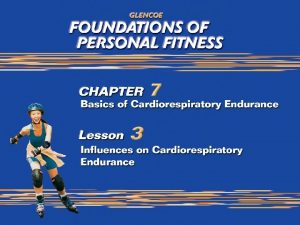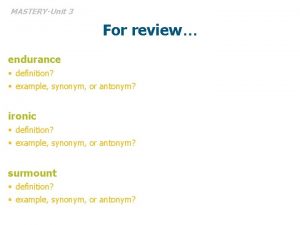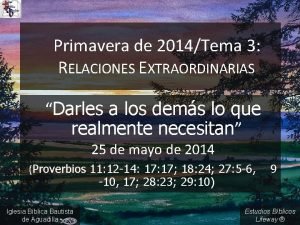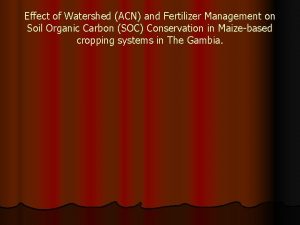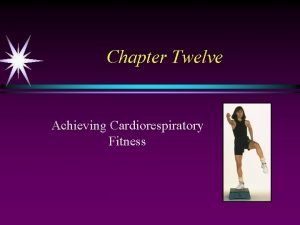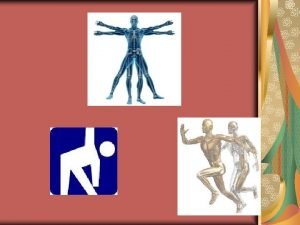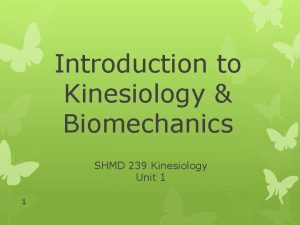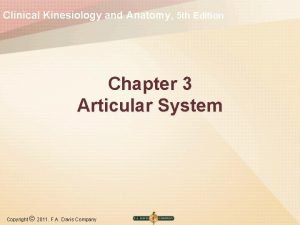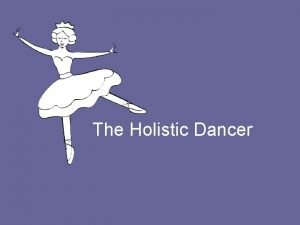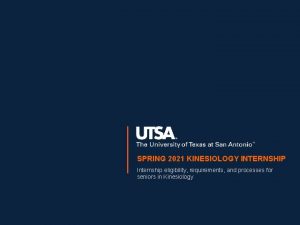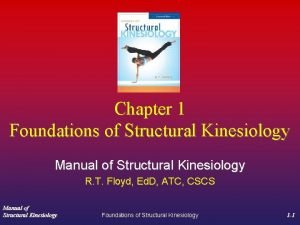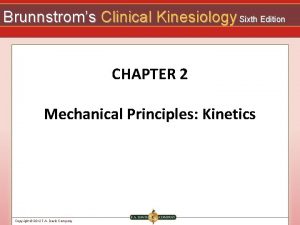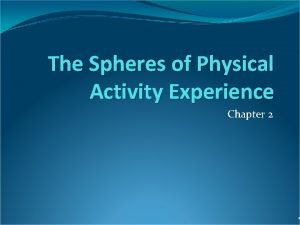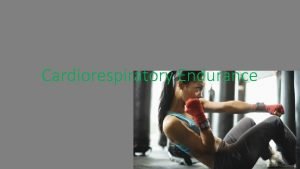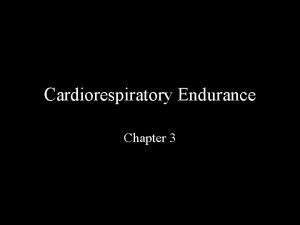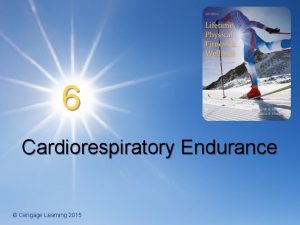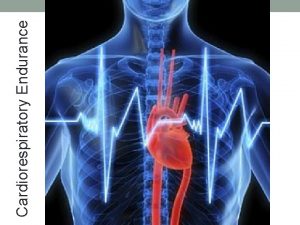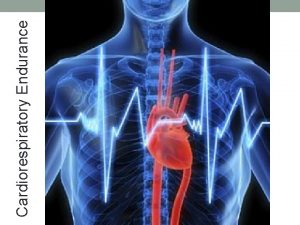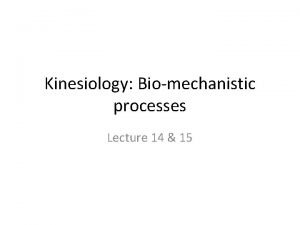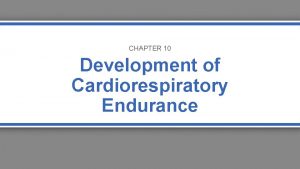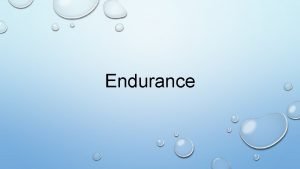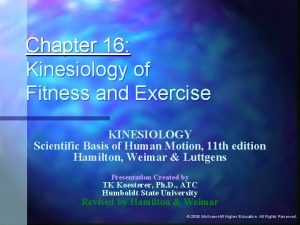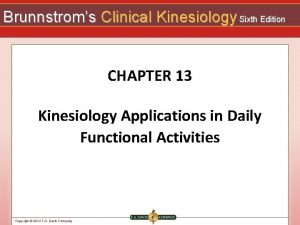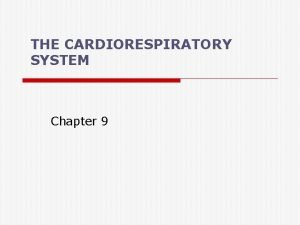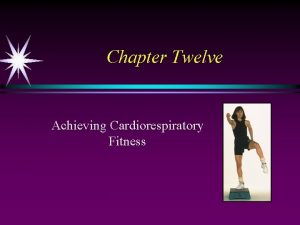Cardiorespiratory Endurance Chapter 2 Kinesiology 2115 Cardiorespiratory Endurance


















- Slides: 18

Cardiorespiratory Endurance Chapter 2 Kinesiology 2115

Cardiorespiratory Endurance (also called cardiovascular endurance) • Describes our energy output • Most important component of physical fitness for longevity • Cardiorespiratory endurance is the ability to supply oxygen to working muscles over a period of time

Function of the CR System • Four components of the CR System – Heart, blood vessels, blood and lungs • Purpose – Take in and deliver oxygenated blood to the cells of the body – Remove deoxygenated blood and other waste products from the body • Which side of the heart pumps deoxygenated blood to the lungs? – ____ atrium and ventricle • Which side pumps oxygenated blood to the body? – _______ atrium and ventricle

Regulation of the CR System • Cardiac Output: the volume of blood pumped per minute – – Average adult volume? Stroke Volume: amount of blood pumped per beat CO = dec HR X inc SV When the body exercises, how much blood is pumped per minute? • With improved fitness, cardiac output will increase stroke volume and consequently decrease heart rate • There is a maximum heart rate! – HR max = 220 - age

Regulation (Continued) • Maximum cardiac output is effected by maximum Heart rate – HR max decreases with age – What happens to COmax with age? • Blood Pressure is also a factor – Blood pressure: the force of blood against vessel walls – Arterial (contraction) pressure is the systolic pressure – Pressure when the heart relaxes (between beats) is the diastolic pressure – Normal BP? – Borderline hypertensive?

Energy Systems • Metabolism – – – ATP (Adenosine Triphosphate) ATP-PC system 1 - 10 seconds Anaerobic system 10 seconds-3 minutes Aerobic system >3 minutes Most activities combine anaerobic and aerobic systems • Maximal Oxygen Consumption (VO 2 max) – Ability to utilize oxygen while working and removing CO 2

Energy Systems (Continued) • VO 2 max is one of the best measures of cardiorespiratory endurance – The higher your VO 2 max, the more you can delay fatigue-oxygen debt – (This means you’re more fit) – You can recover from oxygen debt more quickly – Can be measured in the lab or a field test (examples of lab test: treadmill or

Testing VO 2 Max

Physiological Benefits of CR Endurance • • • Greater CO: more blood, faster Longevity Improved VO 2 max: produce more ATP Lowered blood pressure Reduced body fat, firm muscles Increased metabolism, remains elevated after exercise Increase HDL cholesterol, lower LDL Less bone mineral loss Curbing of appetite

Acute/Chronic Changes with Aerobic (Cardio) Exercise • Acute – – – Increased metabolism Increase CO Systolic blood pressure Ventilation (respiratory rate) Muscle hypertrophy resulting in the slowing of digestion v All return to normal quickly after exercise ends • Chronic – Increased metabolism due to increase in lean muscle mass – Lower resting HR – Increased SV – Increased cellular activity – Increased capillarization of muscle – Improved oxygen utilization, muscle glycogen v Must maintain over a lifespan or changes will revert back

Aerobic Exercise Plan Considerations • • • Precautions Objectives Assess current fitness level Mode Selection Safety Concerns Staying Motivated

Mode of Exercise • Warm-up – 5 -10 minutes LIGHT cardio followed by LIGHT stretching • Activity Period – Overload principle – Intensity (how hard) • Rate of Perceived Exertion (RPE) or • Target Heart Rate range – [(220 -age) – RHR] x % intensity range + RHR – % intensity range dependant upon current health status – – Duration (how long) Frequency (how often) • Cool-down – LIGHT cardio and stretching

Types of Aerobic Exercise High Aerobic Potential Moderate Aerobic Potential Low Aerobic Potential Aerobic dance Basketball Archery Aerobic walking Calisthenics Baseball Bicycling Downhill skiing Bowling Cross-Country skiing Field hockey Football Hiking uphill Handball Golf Jogging Racquetball Softball Rope jumping Soccer Volleyball Rowing Squash Running Tennis (singles) Stair climbing Swimming

Implementing a Program • • Evaluate initial fitness level Schedule exercise as a part of your day Find a variety of modes Keep in target heart rate zone – Increase duration and frequency before intensity • Be aware of overtraining – Start between 500 -2000 calories per week • You don’t want to lose more than 2 lbs per week • 3500 calories = 1 lb

Benefit to Risk Ratio • • • Health Risks (Consult a physician) Sudden illness, hidden heart problems Stop exercising and contact MD if: – Pain in the chest, under sternum, or radiating to the arm; also, any other unexplained pain – Irregular pulse rate (flutters or rapid rate changes) – Palpitations in the chest or throat – Dizziness, lightheadedness, confusion or fainting Note: Anything out of the ordinary, even if you are in shape

Other Health Considerations • Muscle soreness and injuries – Delayed onset muscle soreness is normal - 24 -48 hours later – If it persists, the muscles have been worked too hard • Basic musculoskeletal injuries – – Rest Ice Compression Elevation • Most exercise injuries are caused by poor warmup, mechanics, equipment, increasing intensity or duration too quickly

Preventing Injuries • • Warm-up thoroughly Gradual progression Listen to your body – RICE and ibuprofen Avoid poor biomechanical situations – – Running in one direction Running on slanted roads, downhill Poor shoes Avoid hard surfaces • Substitute with lower impact exercises – Machines (elliptical, stationary bike), swimming, walking

Heat Illnesses • Check temperature and humidity – Adjust duration and intensity – Exercise during cool times, in the shade and wear loose clothing • • • Drink before, during and after exercise Replenish electrolytes (salt, potassium) Sedentary, overweight, older at greater risk • Acclimatize
 Describe cardiorespiratory endurance
Describe cardiorespiratory endurance Another example synonym
Another example synonym Proverbios 2115
Proverbios 2115 (19) 2115-2600
(19) 2115-2600 Tipos de tringulo
Tipos de tringulo Chapter 12 achieving cardiorespiratory fitness
Chapter 12 achieving cardiorespiratory fitness What is kinesiology
What is kinesiology Fixation and stabilization in kinesiology
Fixation and stabilization in kinesiology Biomechanics kinesiology definition
Biomechanics kinesiology definition Degrees of freedom kinesiology
Degrees of freedom kinesiology Repeat
Repeat Ucf kinesiology masters
Ucf kinesiology masters Adbominals
Adbominals Utsa kinesiology internship
Utsa kinesiology internship Canadian kinesiology alliance
Canadian kinesiology alliance Angular motion kinesiology
Angular motion kinesiology Manual of structural kinesiology 18th edition
Manual of structural kinesiology 18th edition Clinical kinesiology and anatomy 6th edition
Clinical kinesiology and anatomy 6th edition Spheres of kinesiology
Spheres of kinesiology
